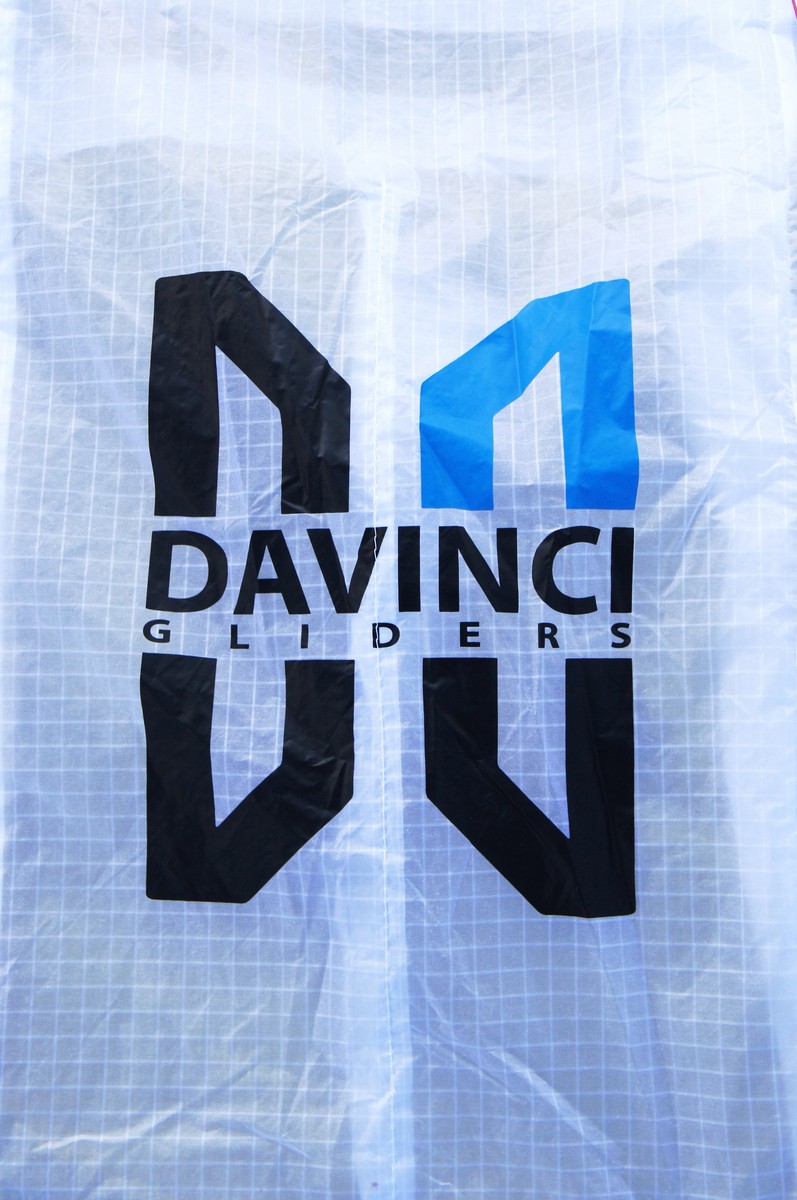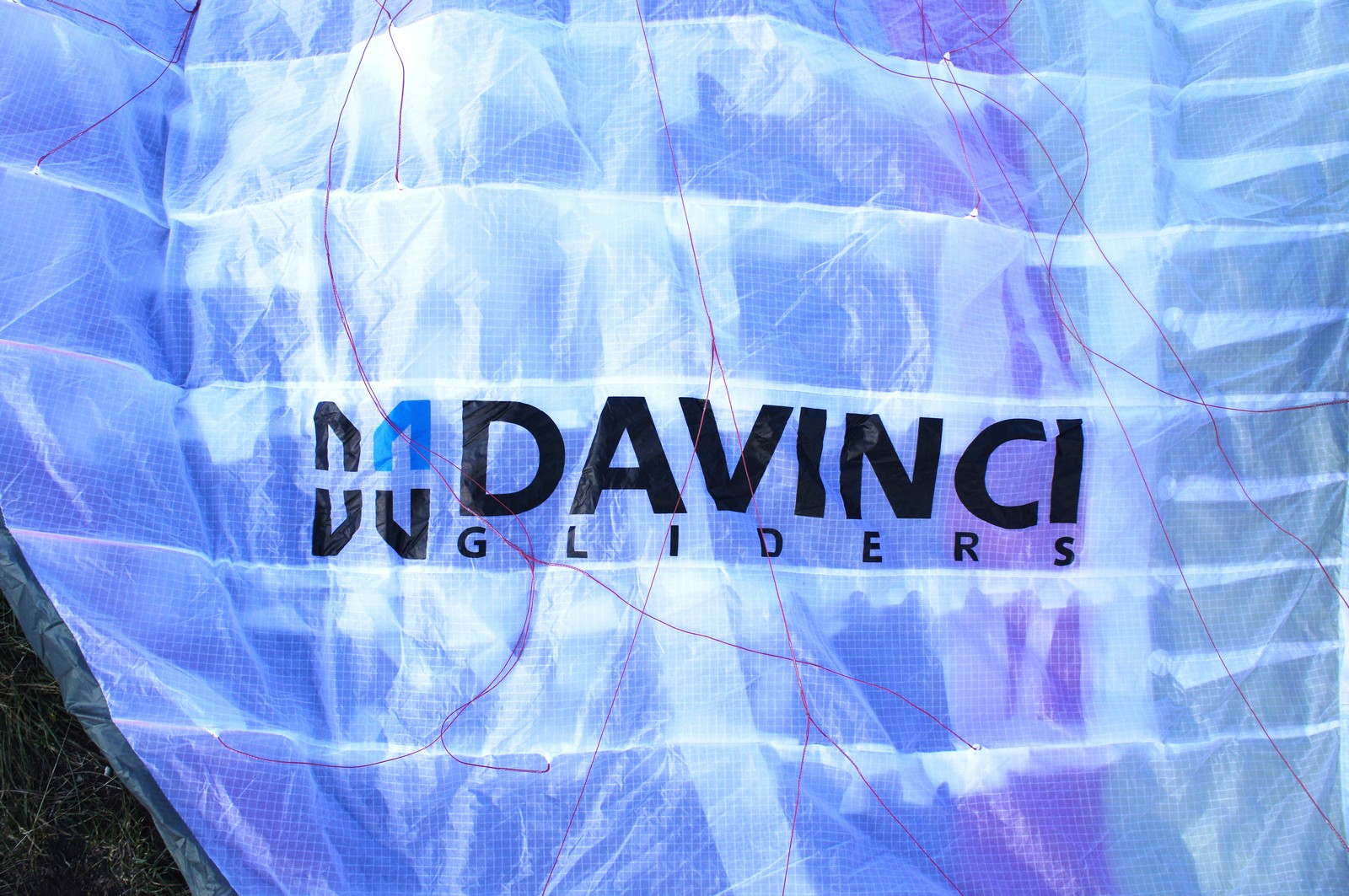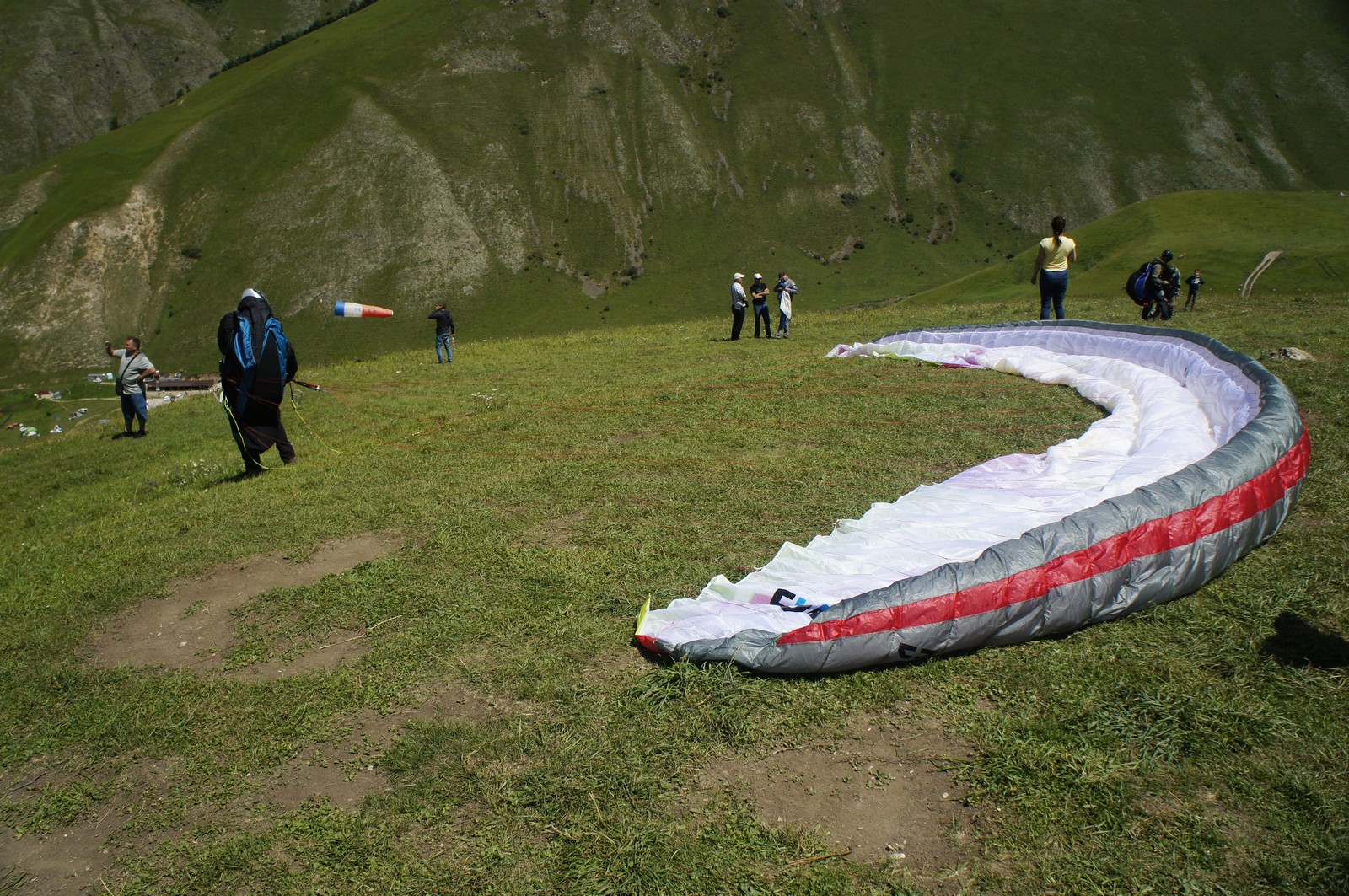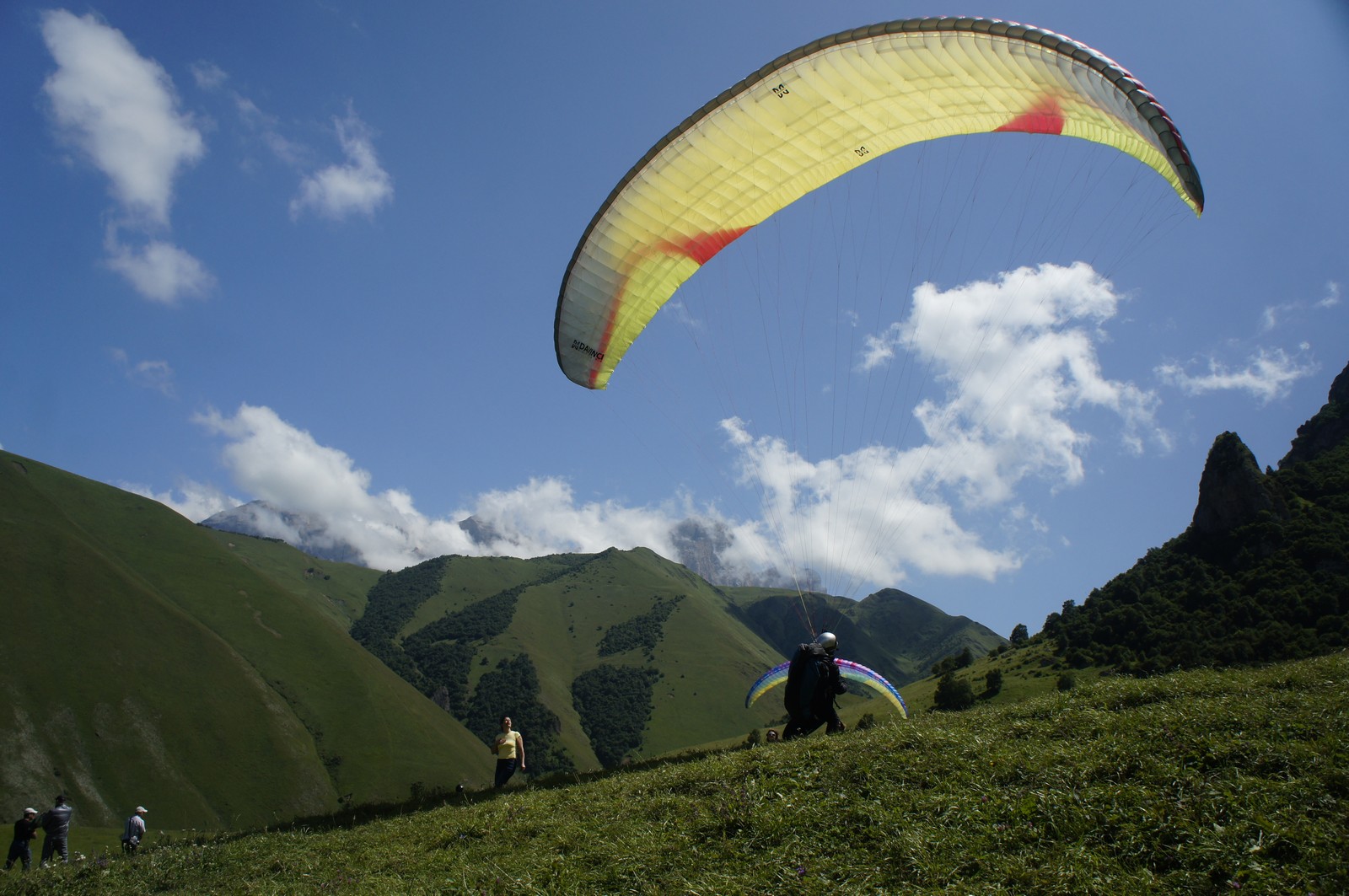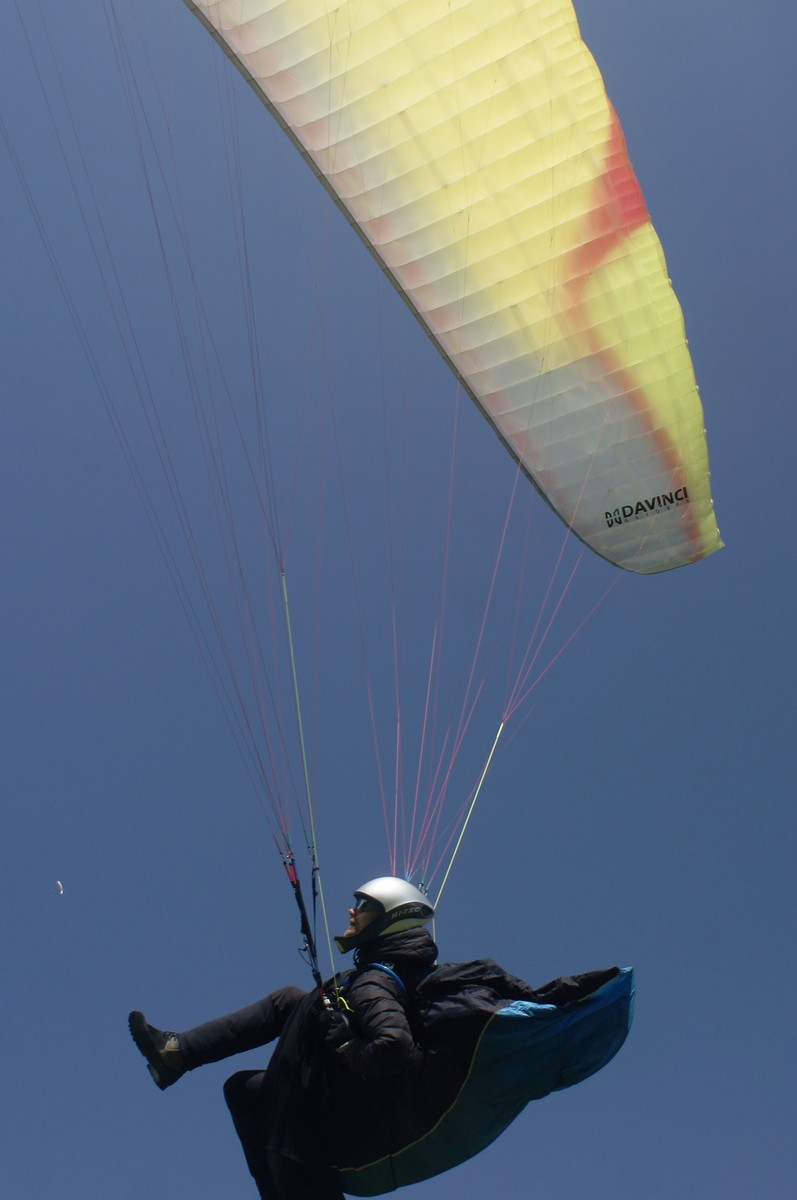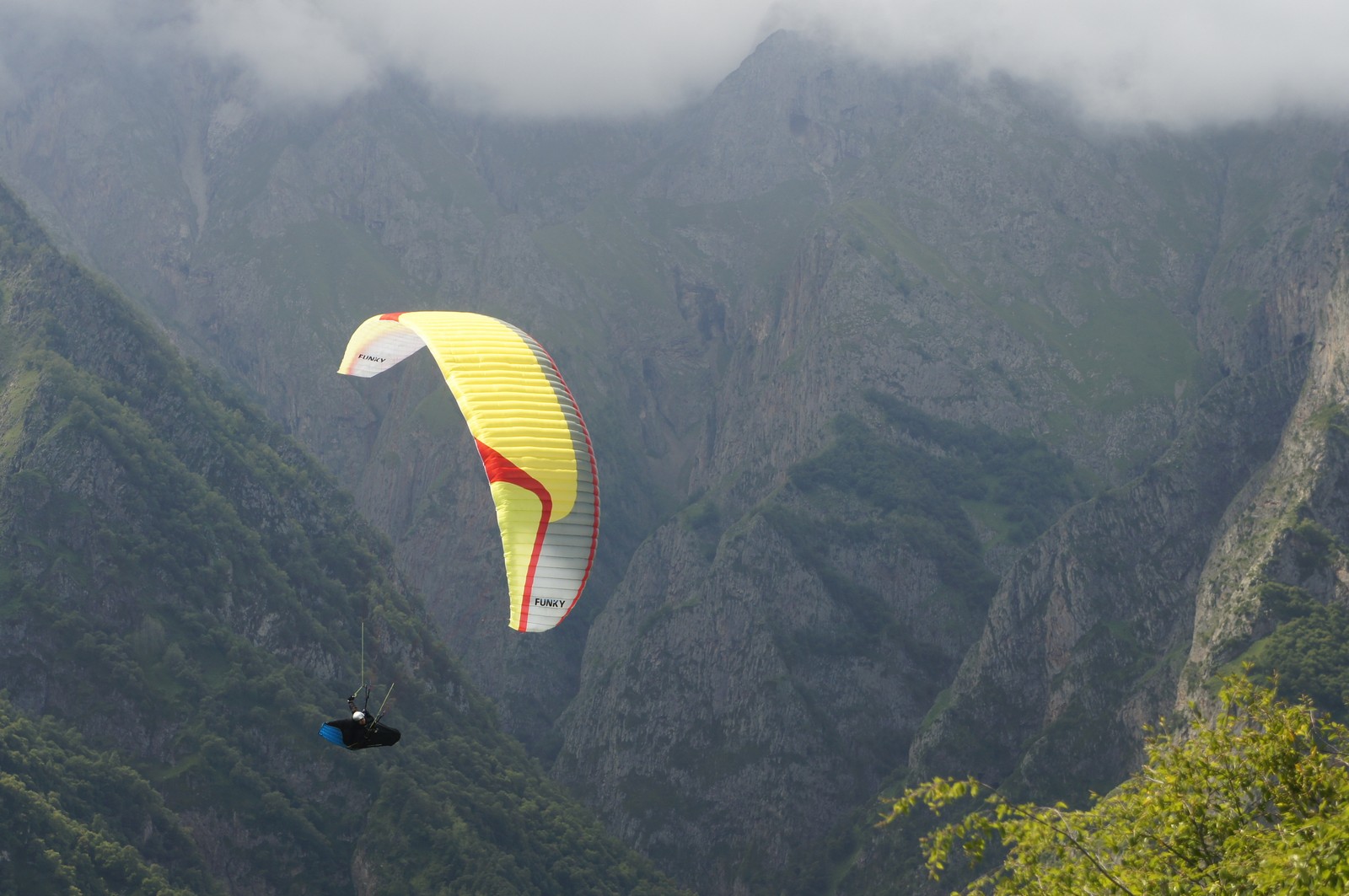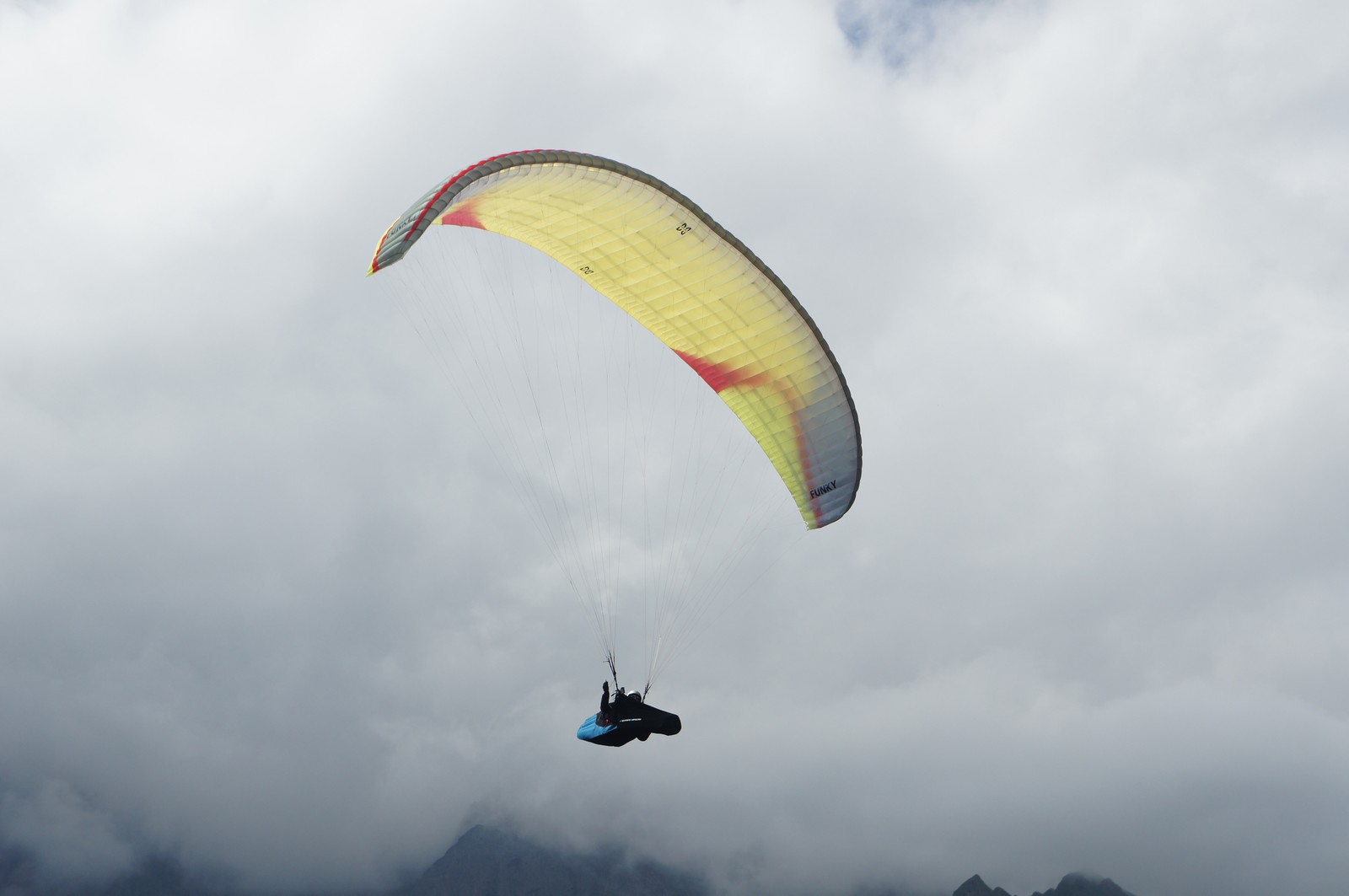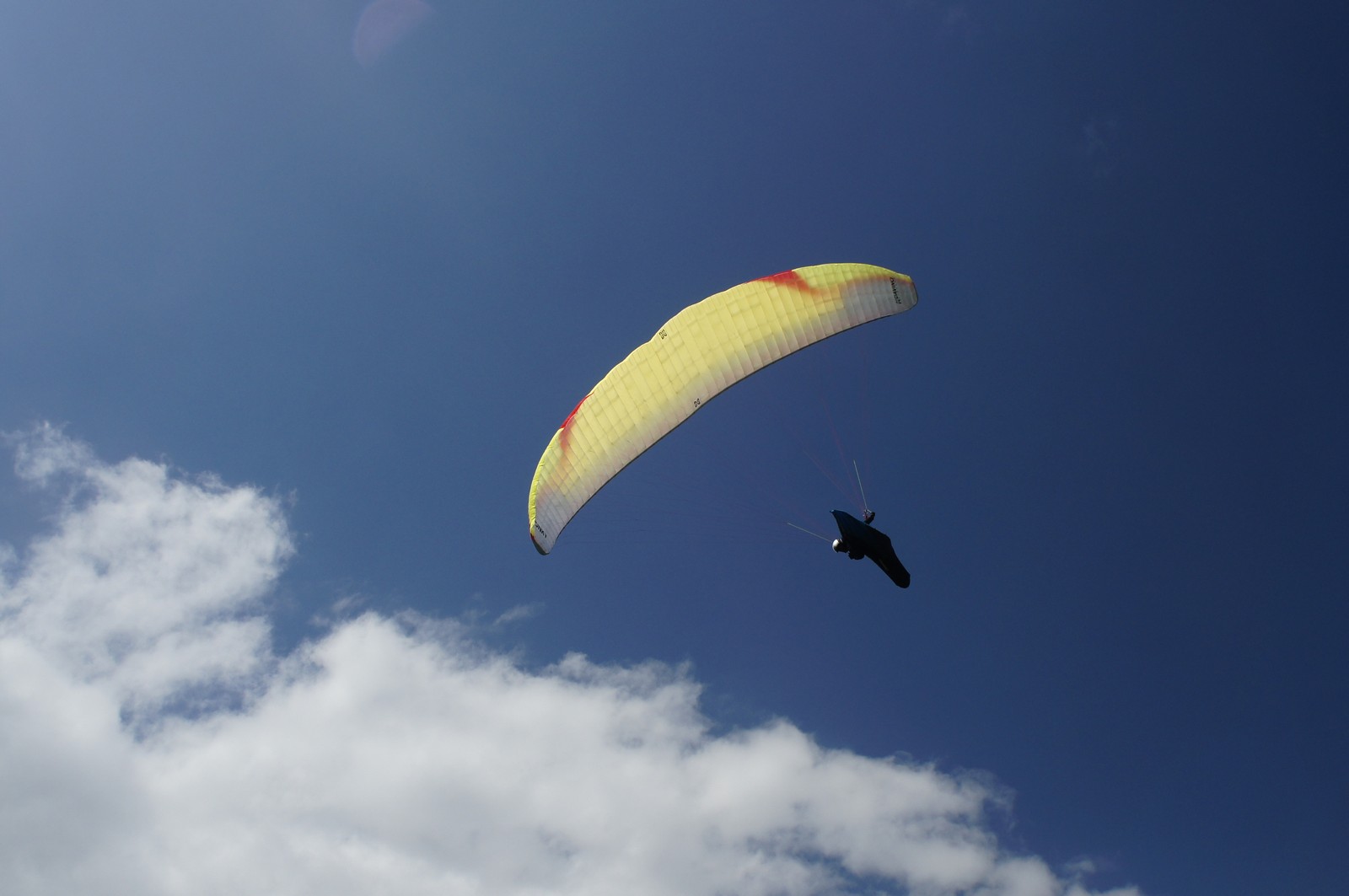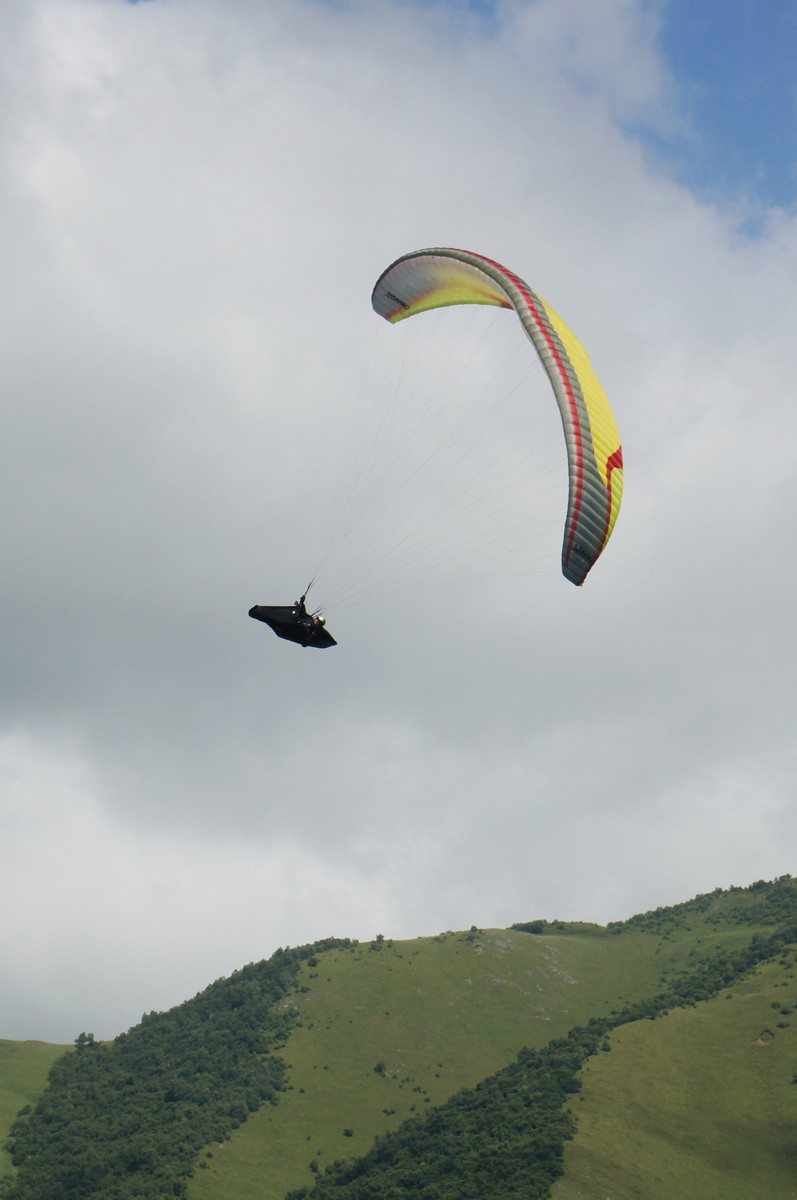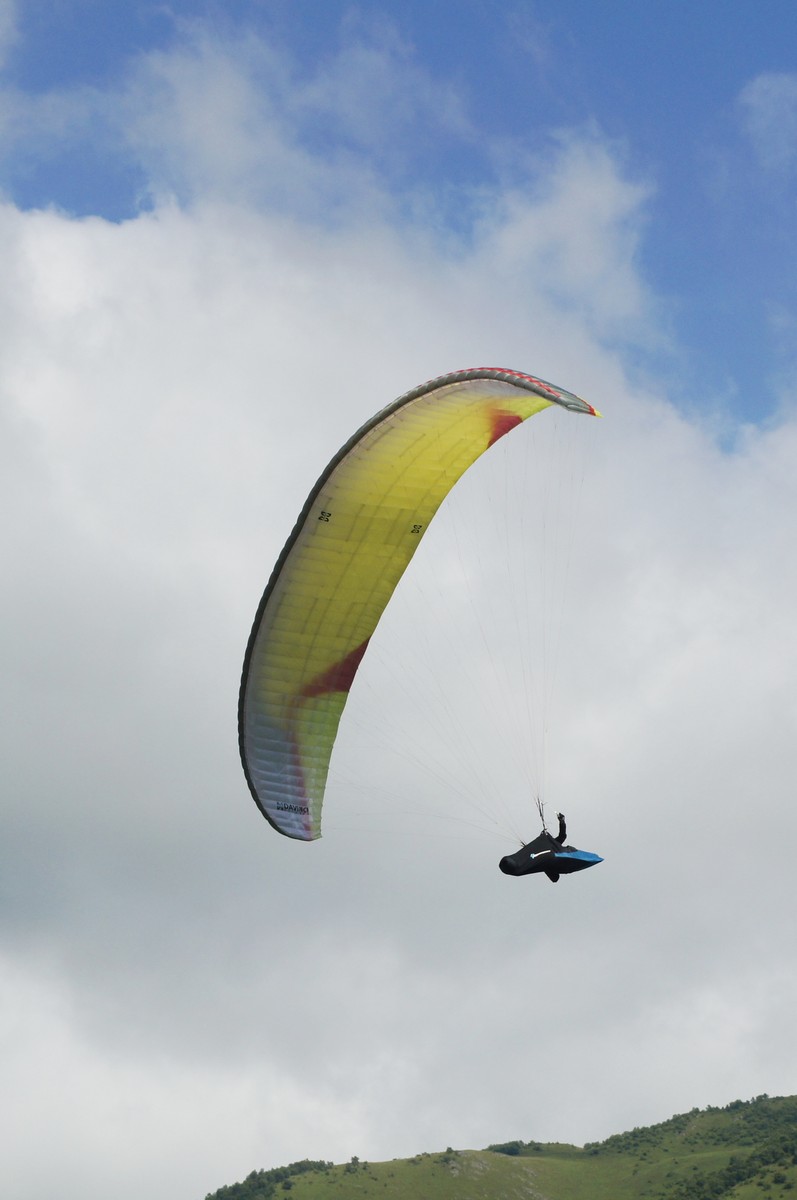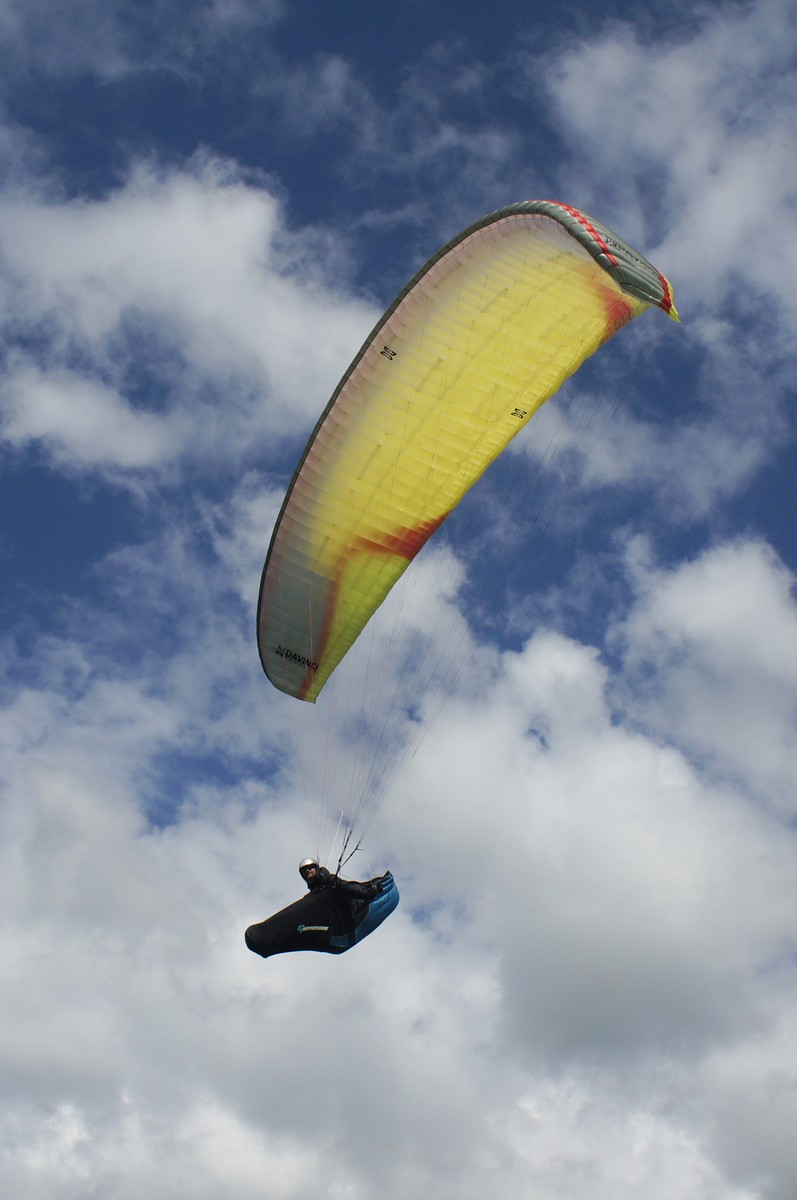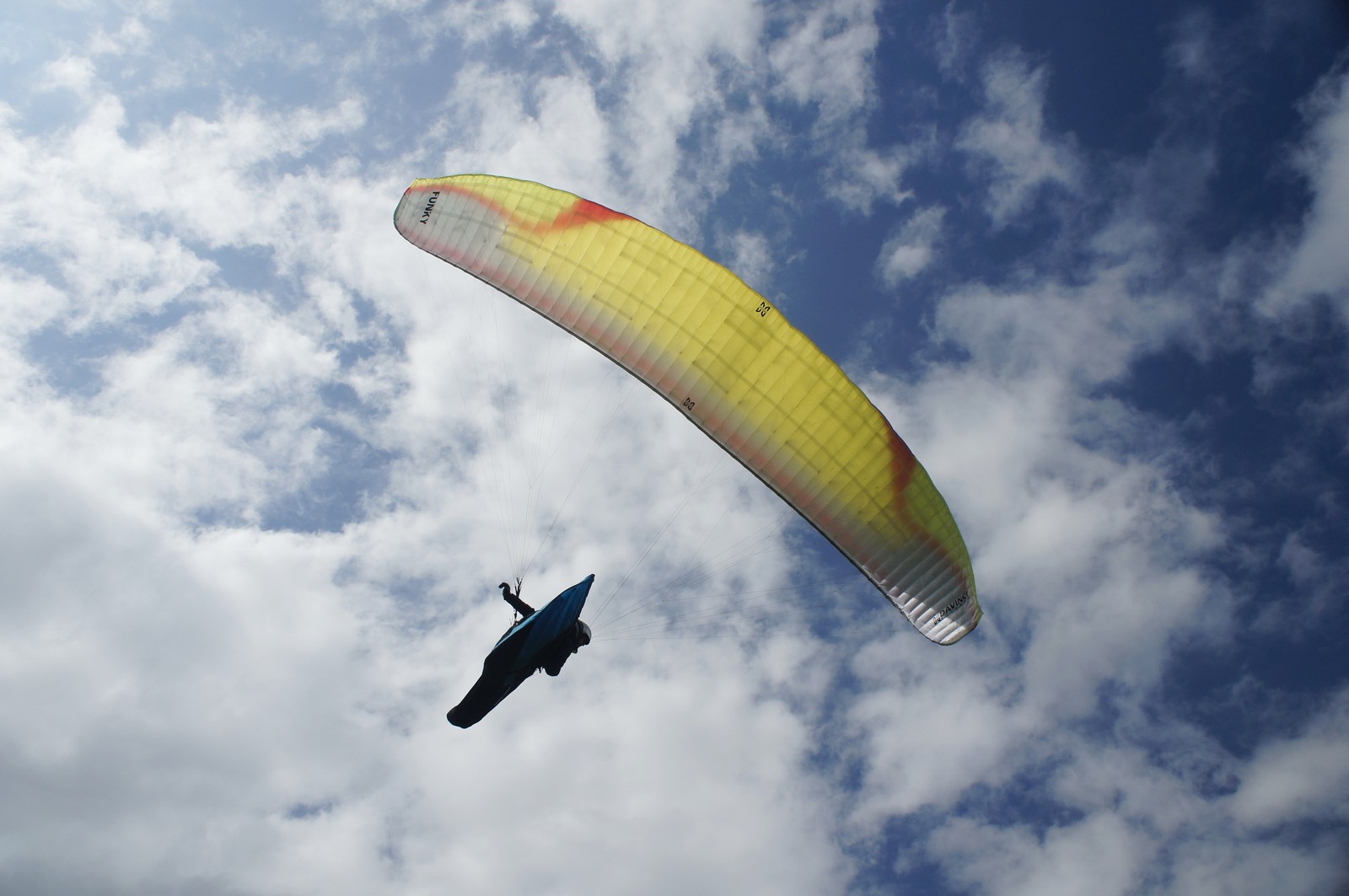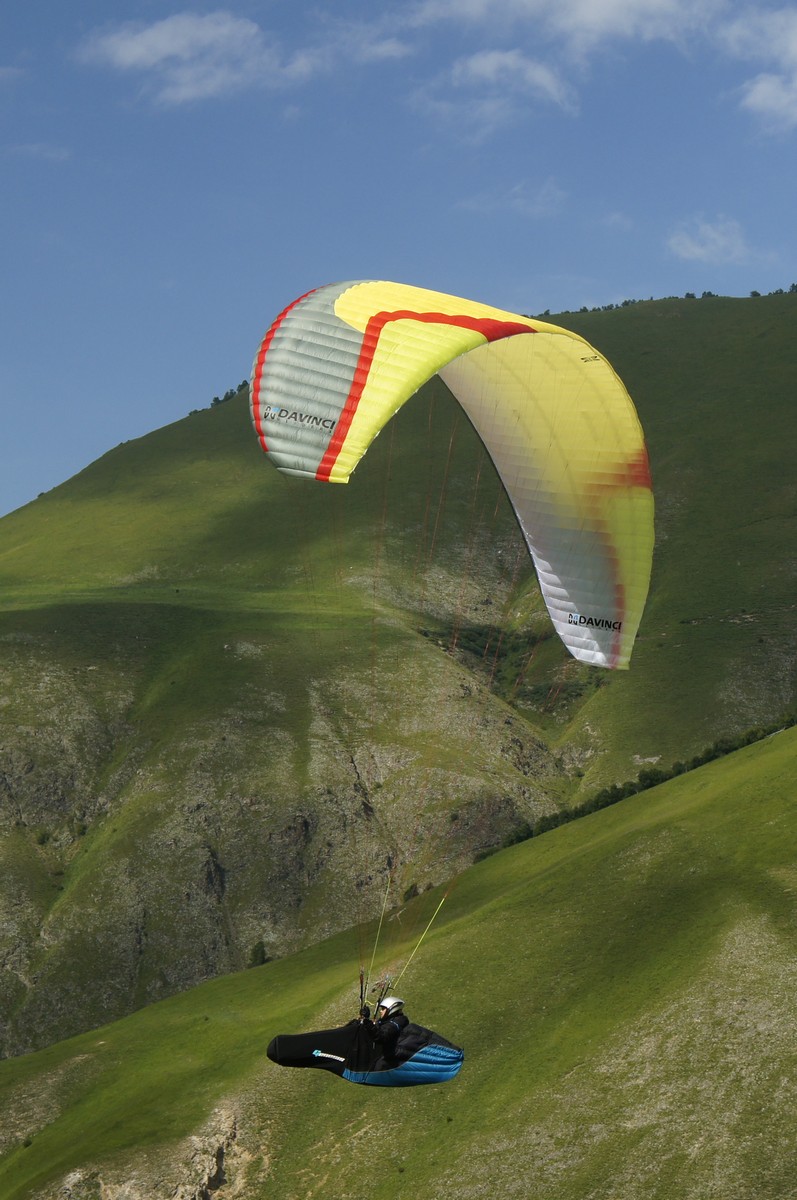The histories of DaVinci and Flow companies are closely connected from their beginning. The first product ranges from both brands were developped in close collaboration, the differences between glider models were mainly in naming and color schemes. But in 2019 the game has changed: being still in collaboration, each brand now follows its own way. The Funky (high EN B) is the first child of this approach. So let's see what is the modern EN B vision from Jihun Lee, DaVinci owner and designer...
Construction
Risers
An interesting mix of classical and original solutions. As to materials, it's 100% classic: the sober black 12-mm webbing is stiff enough to be comfortable while dealing with risers, the speed system pulleys have no bearings but the speed system line is made of low-friction unsheated dyneema. But the cynematic scheme is not very common: there's a separate C' line having its own mini-riser, and the C rows have no handles for steering in accelerated flight. The brake handles, nice and big, have very pleasant magnets and swivels, the brake line slips inside a high quality ceramic ring. The overall manufacturing quality is on par with mainstream paragliding companies, there's nothing to complain.
Lines
Wow it's ambitios! The Edelrid unsheated lines with red anti-UV coating are spreading from the wing bottom surface down to the risers: it's typical for CCC wings but rarely seen in EN B segment. The number of lines is however less radical: there are four lower A lines (instead of 3 or even 2 for the most ambitious EN B gliders). The main loops are protected with some extra webbing and are large enough for tuning by making extra loops. Despite of their small diameter, the lines are not too soft, and there's almos no tangling during pre-flight.
Canopy
Build quality
Surface smoothness
It's the DaVinci vision of high EN B! The A.R. is 5,7: not too high for such a wing, but there's plenty of cells: 59 of which 10 have no intake. Of course there's some shark nose formed by long and stiff plastic rods. Inside the air intakes, there's something never seen before: a long and relatively wide ribbon mimicking a valve but having in fact different functions. Which ones? Ask DaVinci! THe only thibg i know at the time of writing this review is the fact that DaVinci are planning to patent this technical soluton.
The wing shape has a pleasant sporty look. The 3D cut is very successful here, the leading edge is quite sleek. There are however some wrinkles closer to trailing edge but it's not an issue. The internal structure is rather complex and ambitious, with half-ribs and internal ribbons, the maximal unsupported span is 3 sections.
A couple of words about the materials. Making Funky light was definitely not the aim of DaVinci. The heavy duty cloth is used almost everywhere, ensuring good resistance to heavy use but increasing the mass of the glider which is about 5 kg. Not too heavy, but not the level of light and ultralight gliders.
Takeoff and groundhandling
Groundhandling
Almost ideal. The only reason to be not 100% about Funky is its dynamic behaviour during rising. It begins in a nice and smooth way but may end with a powerful forward surge, especially in strong wind conditions, requiring ample and well-timed brake input. In less wind / no wind conditions it's, however, not a problem at all because the wing comes in overhead position in a much smoother manner. As to cobra launch and ear touch, it's a child play for Funky in every weather situation. The glider is collapse resistant, kepping the lower ear opened in most cases, and the reactions to brake input and weight shift are nicely tuned, precise but not too sharp. There's, however, some barely appreciable brake slack during ground handling, but it doesn't bother.
Takeoff
A bit more dynamic that you may expect from high EN B, especially during takeoff from steep slow in windy conditions. In this situation you may need 100% of brake travel during a very short time to keep the glider overhead and prevent the forward surge. But once stopped the glider keeps the takeoff position with ease, patiently waiting for further pilot actions. The brake slack is here again, the glider is quiet docile, but you need unusually ample brake inputs to make the glider really react to them. I think shorter brakes could be better. On the other hand, Funky is very "user-friendly" due to this slack, pardoning inaccurate inputs and requiring very moderate pilot skills.
Flight
Soaring and sink rate
Sink rate in straight flight
Sink rate in spiral
Well done DaVinci! While soaring Funky greatly remains the famous Chili 3 from Skywalk, revealing an impressive degree of efficiency with no regard to wing loading. By the way, i was generally below the middle of recommended weight range which authomatically made me almost a "king of soaring" in weak conditions. It's interesting that this poorly loaded Funky was also very efficient in strong mountain lifts, outperforming many other EN B-labelled gliders, mainly due to its good ability to turn.
Turn ability
Brakes efficiency
Weight shift efficiency
Rear risers control
Another strong point for this glider! But this strength is unpleasantly affected by the aboove-mentioned brake slack, which becomes quite marked while trying to perform sharp turns and other dynamic maneuvers. The first 10 to 15 centimeters of brake travel have almost no effect on pitch and bank, only the airspeed varies slightly. Applying more brakes awakens the Funky and unlocks its aibility to vary the bank which is quite decent. The bank angle changes occur in a smooth manner, they are quite easy to understand. Same for the overall impression while turning. Funky's turn is gentle and calm, with no excessive dynamics. The reactions to brake input are fast and rather sharp... if you don't forget to put your arms low enough to compensate that slack. The brake effort is not very light, the brakes could be less heavy, especially at long brake travels which Funky often has a need of. After a 1,5-hour mountain flight in rough conditions my hands were a bit tired; however it could just mean that the turbulence was stronger than usual.
Back to brakes slack. DaVinci says that this slack was intentionally introduced for further increase of passive safety (maybe it's a gift for poorly experienced pilots who may use brakes amply and not very precise). The Funky of M size accepts the brakes shortening of about 4-5 cm without negative effects. In most cases it's more than enought to remove that anoying slack.
The reaction to weight shift is less pronounced than reaction to brakes but still very pleasant. Funky easily does steep spirals, revealing no tendency to have spiral neutrality.
A couple of words about rear risers control. There's no dedicated handle on rear risers, so you may think that Funky is not really designed for rough use of speed system. Mistake! In fact the rear risers are pleasantly light, and the rear risers control is really efficient, quick and sharp. It's interesting that Funky reacts well on pulling the rear risers horizontally, which is enough to control this glider in most situations of high speed flying.
Comfort and feedback
Comfort
Feedback
It's hard to say how confortable is Funky because the level of comfort offered by this glider strongly depends on weather conditions. It happened to me to fly Funky in really rough staff, and it wasn't very confortable, mainly because of powerful forward surges which may occur suddenly and require a very ample brake input (you still remember about the brake slack, yes?). The first time it happened i've got a real-life frontal just because i didn't expect that the typical 30-centimeters brake input will not stop that surge. In fact, this Funky demands much more ample input! There are also some good news: Funky recovers from the real life collapses in a very fast and correct manner, so they're almost non-events. Later in the same flight i was aware enough to keep both brakes slightly down and to use them plenty when the things were getting rough, and this really helped. With such a degree of control, the Funky has become more user-friendly but still demanded some ample hand job time up to time. No more collapses that day, but i was however impressed by the amount of brake input ths Funky may require.
Later i was flying in much softer conditions, and it was just another story. This time Funky was very user-friendly, with very limited surges and absolutely no collapses.
The feedback offered by Funky is abundant and quite original. This glider tansfers a lot of information to the harness: a kind of soft but powerful "bangs" speaking clearly about what's happening in the air near the glider. The changes of airspeed are only a bit less informative: their range is great, but they occur in a smooth and confortable manner. Again, the pitch behaviour is rather specific, the sudden surges are possible, but they happen only in strong conditions, so in general the Funky requires very reasonable amounts of pitch control. In this "Funky case", an ample pitch is a clear sign that a strong lift is near, and counteracting such a pitch is generally followed by entering the core. In calmer conditions Funky is much more dampened on pitch, giving only very limited feedback. The roll dampening is definitely above average; Funky tends to conserve its roll angle even in the rough staff, easily and smoothly restoring the initial pitch angle if it was changed by turbulence. The brakes feedback is not very obvious because of high loads at typical brake travels. Lighter brakes with less slack could be better because of better feedback.
Dynamics and energy retention
Dynamics
Energy retention
Pleasantly average or slightly above. One of the best ways to check glider dynamics and energy retention are wingovers, and Funky does them in a rather classical manner: they are smooth and well controllable by pilot. The amount of energy accumulated during wingovers is however above average even at moderate wing loading. The same for the steep spirals which demand a bit more attention than usual because high speeds and high brakes sensitivity are being built very quickly. The landing swoop is also impressive for a high EN B glider.
Glide
One of the most questionable parts of each test flight. Here i will be mostly subjective again because it's not so easy to manage an ideal test session with many gliders of the same class flying side by side. So my subjective opinion is that Funky has one of the best glides in its class. It' not the absolute leader of high EN B group but the general level of performance is very decent. In fact, Funky's performance level in the middle part of the polar is more or less on par with Skywalk Chili 4 and Sup'Air Step which i consider as milesotnes in EN B class. I didn't feel any lack of glide while flying together with some intermediate gliders and even with some EN C labelled wings. It appears that Funky truly deserves its high EN B positioning defined by manufacturer.
Accelerated flight
Speed gain
Speed system effort
Speed system travel
Good... except the speed gain which appears to be slighlty less than expected for an advanced EN B. My wireless Pitot tube measured +5 km/h at 50% of speed system travel, +10 km/h with pulleys beginning to overlap. Okay, not a class-leading level. But there are also good news: Funky's speed system is very usable in any kind of conditions including the rough staff. At full speed, the glider remains user-friendly and well-dampened, and the glide doesn't degrade appreciably. It means that you can push the speed system to the limit in almost any kind of conditions. By the way, the speed system travel and effort are quite moderate, encouraging to use the speed system quite intensively.
Dangerous flight regimes
Asymmetric collapse
Perfect! And classical. The load on A riser is high, got some almost-collapses until pulling the A riser plenty. If enough effort is applied to A riser, the collapse occurs at last, goind moderately deep chordwise and instantly inducing some roll. The rocking back is very limited in amplitude. The opening is smooth and gradual, perfectly complying the EN B requirements. The course deviation is generally around 60 degrees, the pitch+roll is only about 30 degrees, the height loss is mere 10 meters. A couple of ear sections may sometimes remain collapsed having no effect on glider behaviour which is very easy to understand. No special control technique is required, the glider even pardons some of the most typical errors like excessive brake input and delayed/incorrect weight shift.
Asymmetric collapse
Perfect again. The only difference is slightly more dynamics and more possibility to have the wingtips tangled after the most part of the wing is reopened. The angles are also increased: pitch+roll angle can reach 45 degrees, the course deviation is close to 90 degrees.
Frontal collapse
It's funny that, during a frontal collapse, the Funky behaves like some of Niviuk 2-liners. It's hard to provoke a frontal collapse because of high load on A risers. The collapse develops moderately deep chordwise, and releasing the risers provokes a powerful surge and an instant "parachute-like" reopening, all this in almost no time. The reopening is so quick that the glider looses only 10 meters of height or less, but the dynamics of the recovery process is quite impressive.
Spin out of thermal spiral
Not all of modern EN B gliders allow this trick. But, despite the abouve-cited brake slack and generally long brake travel, The Funky can potentially be stalled by its pilot while thermalling. But you need to push breakes really hard to do so. In my case the Funky was entering the stall at the very limit of available brake travel, and the brake effort was quite heavy. It's almost impossible that a typical EN B pilot could occasionally make such a mistake. The brake effort decrease at the beginning of the stall is quite subtle, but the stall develops slowly, the pilot has at least a couple of seconds to recognize the problem and to rise the hand. The recovery to thermal spiral is perfectly fast, the surge is powerful but very limited in amplitude.
Quick descent techniques
Ears
Stability
Sink rate
Almost ideal in terms of stability. The effort on external A lines is big at the beginning, drastically diminishing after the collapse occurs. Keeping the ears closed is a child's play, they require a minimal effort of A lines and are very stable. It's perfect compared to certain gliders which have a very deep-stall-like behavior with both ears closed... but it's less perfect in terms of sink rate. I measured only -2 m/s. Not very effective, maybe because of low wing loading during tests. The reopening requires some brake input or a couple of weight shifts.
Ears, accelerated
Stability
Sink rate
Almost the same as without speed system, the only difference is the sink rate which increases up to 3 m/s.
High EN B is always a very special case for paraglider manufacturers. The high EN B gliders are the most popular gliders, and the concurrence in this market segment is quite high, encouraging pilots to make their choice by taking even the small details into consideration. So what about Funky? It's a funky thing! Maybe it's not ideal, but it has its own unique appearance, temper and style suiting typical pilot's demands. The combination of decent performance level and high passive safety is very attractive, allowing us to pardon the random and sudden pitches in heavy turbulence and some brakes slack. But it's generally an interesting and pleasant glider, able to find its own place on the market.
The typical Funky owner is an intelligent pilot aiming to have a very cost-effective glider with perfect performance-to-price ratio. DaVinci is still a young brand offering interesting products at fair prices, thus being a strong contender to popular and well-known brands. For its very reasonable price, Funky offers a good level of performance, a slightly spicy temper and a great reserve of passive safety. The application range for Funky is quite wide, so it's easier to define what Funky is NOT suitable for. It's not a vol-biv glider because of its long-lasting but relatively heavy construction. It's not the first EN B because it's a bit too "hot" for that. It's not a sport class competition winner because DaVinci didn't sacrifice the passive safety to reach the ultimate performance levels. But in any other case it's the right choice! The minimal pilot skills are around 40 flight hours during 1-2 flying seasons.
Pros
- Pleasant temper
- Decent general level of performance
- Long-lasting construction made from non-ultralight cloth
Peculiarities
- Some brake slack (10-15 cm) intentionally introduced by manufacturer
- Prone to pitch surges in strong turbulence
Thanks
My cordial gratitude to:
- Rinat Sabitov for offering the glider for testing
- Roman and Natalia Saveliev for help with logistics and test flights organization
- Ilya Shingarev for perfect fotos
Copyright
- Foto: I. Shingarev, A.Tarasov
Technical data
| Flat area, sq. m. | 28,9 |
| Flat A.R. | 5,7 |
| Flat span, m | 12,8 |
| Projected area, sq. m. | 24,4 |
| Projected A.R. | 4,3 |
| Projected span, m | 10,1 |
| Cells, total | 59 |
| Cells, closed | 10 |
| Cord min, m | 0,79 |
| Cord max, m | 2,74 |
| Cord average, m | 2,25 |
| Lines height, m | 8,09 |
| Lines scheme | A2A'1B4C3 |
| Accelerator travel, mm | 140 |
| Takeoff weight, kg | 95-120 |
| Glider weight, kg | 5,0 |
| Size | L |
Materials and components
| Upper surface, leading edge | Dominico Textile | 20D MF(WR) |
| Upper surface except leading edge | Dominico Textile | 20D MF(WR) |
| Bottom surface | Porcher | E3H |
| Ribs, supported | Dominico Textile | 30D FM(Non WR) |
| Ribs, unsupported | Dominico Textile | 30D FM(Non WR) |
| Diagonal ribs | Dominico Textile | 30D FM(Non WR) |
| Lines, upper cascades | EDELRID | 8000U-90/70 |
| Lines, middle cascades | EDELRID | 8000U-190/130 |
| Lines, main (lower) cascades | EDELRID | 8000U-280/230/190 |
| Risers, webbing | Guth&Wolth GMBH | 12mm |



